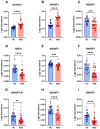N-glycosylation patterns of plasma immunoglobulin G in anti-synthetase syndrome disease
- PMID: 40607430
- PMCID: PMC12214897
- DOI: 10.3389/fimmu.2025.1538219
N-glycosylation patterns of plasma immunoglobulin G in anti-synthetase syndrome disease
Abstract
Introduction: Anti-synthetase syndrome (ASS) is a subtype of idiopathic inflammatory myopathy (IIM) characterized by characteristic rash, myositis, and interstitial lung disease (ILD). The etiology of ASS is unknown, and patients have a poor quality of life and are prone to pulmonary infection. Recent studies have elucidated the potential role of abnormal glycosylation of immunoglobulin G (IgG) in the pathogenesis of autoimmune diseases. However, the pattern of patient-specific IgG N-glycosylation in ASS has not been fully elucidated.
Methods: the GlycoQuant method was used to quantify the intact N-glycopeptides of IgG from 30 ASS patients and 30 healthy controls (HCs).
Results and discussion: Thirteen differentially expressed intact N-glycopeptides were identified (p<0.05). Notably, we observed increased fucosylation (p<0.0001) and decreased N-acetylneuraminic acid (p<0.05) in ASS patients. In addition, specific glycosylation patterns correlated with lung function parameters. Our study revealed the IgG glycosylation profile in ASS patients and provided a valuable reference for further investigation of its potential diagnostic and prognostic applications.
Keywords: N-glycosylation; anti-synthetase syndrome (ASS); autoimmune disease; immunoglobulin g (IgG); intact N-glycopeptide.
Copyright © 2025 Zhao, Li, Ling, Wu, Wu, Tan, Cheng, Huang, Liu and Zhang.
Conflict of interest statement
The authors declare that the research was conducted in the absence of any commercial or financial relationships that could be construed as a potential conflict of interest.
Figures





Similar articles
-
Dynamics of interstitial lung disease following immunosuppressive treatment differ between antisynthetase syndrome and systemic sclerosis.Ther Adv Respir Dis. 2025 Jan-Dec;19:17534666251336896. doi: 10.1177/17534666251336896. Epub 2025 May 8. Ther Adv Respir Dis. 2025. PMID: 40337907 Free PMC article.
-
Prevalence of Anti-Synthetase Syndrome in Patients of Interstitial Lung Disease with Connective Tissue Diseases and Autoimmune Features: A Cross-Sectional Study.Mediterr J Rheumatol. 2025 Mar 31;36(1):107-115. doi: 10.31138/mjr.180324.dtc. eCollection 2025 Mar. Mediterr J Rheumatol. 2025. PMID: 40557171 Free PMC article.
-
A robust label-free workflow for the immunoglobulin G subclass site-specific N-glycopeptides and the glycosylation of IgG 2 correlated with colorectal cancer.Talanta. 2026 Jan 1;296:128326. doi: 10.1016/j.talanta.2025.128326. Epub 2025 May 22. Talanta. 2026. PMID: 40466447
-
Antibody tests for identification of current and past infection with SARS-CoV-2.Cochrane Database Syst Rev. 2022 Nov 17;11(11):CD013652. doi: 10.1002/14651858.CD013652.pub2. Cochrane Database Syst Rev. 2022. PMID: 36394900 Free PMC article.
-
A systematic review of adult-onset clinically amyopathic dermatomyositis (dermatomyositis siné myositis): a missing link within the spectrum of the idiopathic inflammatory myopathies.J Am Acad Dermatol. 2006 Apr;54(4):597-613. doi: 10.1016/j.jaad.2005.10.041. Epub 2006 Jan 23. J Am Acad Dermatol. 2006. PMID: 16546580
References
-
- Nakashima R, Imura Y, Hosono Y, Seto M, Murakami A, Watanabe K, et al. The multicenter study of a new assay for simultaneous detection of multiple anti-aminoacyl-tRNA synthetases in myositis and interstitial pneumonia. PLoS One. (2014) 9,:e85062. doi: 10.1371/journal.pone.0085062 - DOI - PMC - PubMed
MeSH terms
Substances
Supplementary concepts
LinkOut - more resources
Full Text Sources
Medical
Miscellaneous

